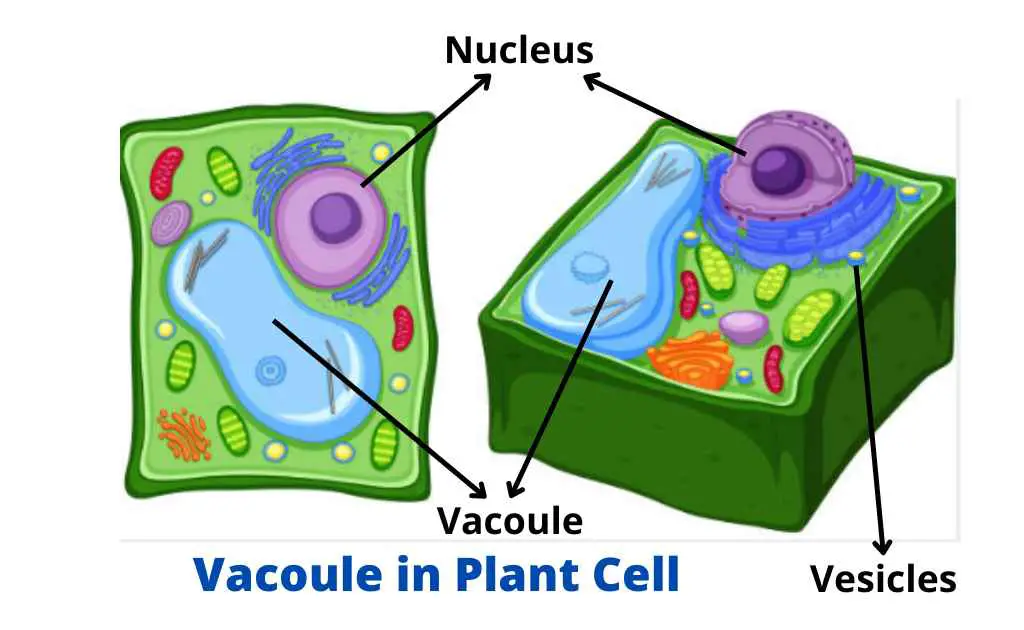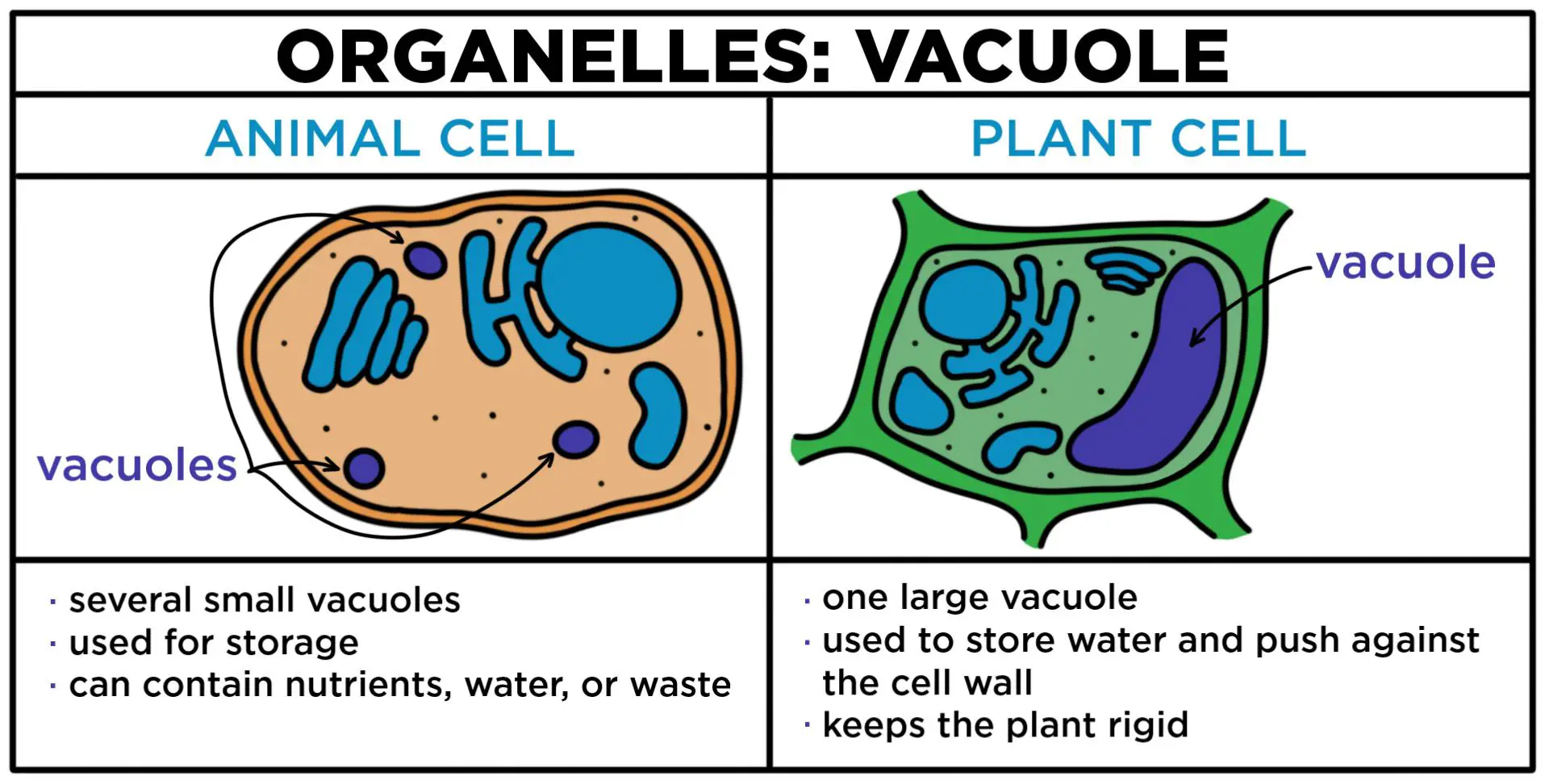Plant vacuoles and animal vacuoles are cellular compartments with distinct characteristics and functions. Plant cells typically contain a large central vacuole that occupies a significant portion of the cell’s volume. Animal cells may have multiple small vacuoles or none at all. Unlike plant vacuoles, animal vacuoles are relatively small and not as prominent.
What are vacuoles?
Vacuoles are membrane-bound organelles found in both plant and animal cells. These organelles serve as storage inside the cell. However, there are differences between plant and animal vacuoles. Plant vacuoles are larger in size and occupy about 90% of the cellular space. They are single in number and surrounded by a tonoplast, a membrane that prevents the intermixing of substances from the cytoplasm. Plant vacuoles store water, metabolites, and nutrients. They also maintain the turgor pressure of the cell, which is important for the shape and rigidity of plants. In contrast, animal vacuoles are smaller in size and are often scattered throughout the cell. They store nutrients, ions, and water and play a role in osmoregulation, storage, excretion, and digestion.
Vacuoles can be categorized into three different types: gas vacuoles, contractile vacuoles, and food vacuoles. Gas vesicles or gas vacuoles exist in certain bacterial species and help control their buoyancy. Many protists have contractile vacuoles, which serve as osmoregulatory organelles. Food vacuoles are also seen in protists and act as storage organelles that store water, ions, and nutrients. They also maintain the rigidity and turgor of the cell and isolate contaminants or waste products.
Importance of vacuoles in cells

- Plant and animal cells both contain vacuoles, which are membrane-bound organelles that serve as storage for essential elements in the cell. While both plant and animal vacuoles act as storage, they differ in size, number, and significance.
- Plant vacuoles are essential in maintaining the turgor pressure of the cell, occupying up to 90% of cellular space. They store water, metabolites, and nutrients, and also play a vital role in detoxifying heavy metals in the cell. On the other hand, animal vacuoles are usually small and scattered. They typically contain fluid, food, and metabolic wastes and are essential in maintaining osmotic concentration, excretion, and digestion.
- Vacuoles are significant in plant cells as they cannot move to find nutrients and water. Thus, plant cells have larger vacuoles than animal cells. In contrast, most animal cell vacuoles play subordinate roles in larger life processes. However, vacuoles play crucial roles in both plant and animal cells in maintaining the stability of the cell.
Structure and Composition of Plant Vacuoles
Plant vacuoles are distinct structures that occupy nearly 90% of the space within the cell. These organelles are surrounded by a tonoplast, separating their contents from the cytoplasm. Plant vacuoles are much larger than those found in animal cells, and their primary function is to maintain the turgor pressure of the cell. They store water, metabolites, and nutrients, making them essential for the survival and growth of plants.
- In contrast, animal cells have several small and scattered vacuoles, which contain fluid and food. These structures are temporary and aid in the endocytosis and exocytosis processes. Animal vacuoles have less significance than those found in plant cells. However, some animal cells, such as those in protozoa, may have contractile vacuoles for osmoregulation.
- The central vacuole in plant cells is enclosed by a membrane called the tonoplast and is an important component of the plant internal membrane network system. It slowly develops as the cell matures through the fusion of smaller vacuoles. The central vacuole is highly selective in transporting materials through its membrane, creating a chemical palette that differs from the surrounding cytoplasm and containing pigments that give flowers their characteristic colors. Additionally, the central vacuole plays a vital role in plant growth, storing salts, minerals, nutrients, proteins, and playing an important structural role.
- Plant vacuoles are essential for maintaining turgor pressure, controlling osmotic pressure, and molecular degradation and storage. Interestingly, some materials commonly stored in plant vacuoles, such as opium, rubber, and garlic flavoring, have been found to be useful for humans. The study of these unique organelles continues to yield fascinating insights into plant biology.
Structure and Composition of Animal Vacuoles
Plant and animal cells both contain vacuoles, but there are significant structural and functional differences between the two. Plant vacuoles are a single, massive structure that can occupy up to 90% of the cell’s volume, while animal cells have several small and scattered vacuoles. Additionally, plant vacuoles are surrounded by a tonoplast, which prevents intermixing of substances from the cytoplasm.
- The main function of plant vacuoles is to maintain the turgor pressure of the cell. They store water, metabolites, and nutrients, which are essential for plant growth and development. The plant vacuole also contains water-soluble pigments and can act as a detoxifying organelle, detoxifying heavy metals inside the cell.
- In contrast, animal vacuoles are of less functional significance. They mainly contain fluid, food, and metabolic wastes. They also aid in the endocytosis and exocytosis processes. Some vacuoles are created by endocytosis, which involves the uptake of substances from the extracellular environment into the cell.
- The size difference of vacuoles in plant and animal cells is due to the fact that plants cannot move to find nutrients and water, so they must store these essential substances in large quantities in their vacuoles. However, animal cells can move to obtain nutrients and water, so their vacuoles are smaller and have a more subordinate role in the cell’s larger life processes.
Difference Between Plant Vacuole and Animal Vacuole
Plant and animal cells both have vacuoles, but they differ significantly in terms of size, number, and function. Here are the key differences:
- Size and number: Plant vacuoles are much larger than animal vacuoles, and they can occupy up to 90% of the cell’s total volume. On the other hand, animal vacuoles are smaller and more numerous, typically scattered throughout the cytoplasm or concentrated in specific regions.
- Structure: Plant vacuoles are enclosed by a single membrane called the tonoplast, while animal vacuoles may or may not have a membrane.
- Function: Plant vacuoles play a vital role in maintaining the turgor pressure of the cell and storing water, nutrients, and pigments. They also help detoxify heavy metals and may contain digestive enzymes. Animal vacuoles have various functions such as osmoregulation, storage, excretion, digestion, and endocytosis/exocytosis.
- Types: There are three main types of vacuoles: gas vacuoles, contractile vacuoles, and food vacuoles. Gas vacuoles are present in some bacteria and protists; contractile vacuoles help regulate osmotic pressure in many protists; and food vacuoles are involved in digestion and nutrient storage.
Conclusion
Plant cells and animal cells have some significant differences, including the presence of vacuoles. Vacuoles are membrane-bound subcellular structures that play crucial roles in different cellular processes like intracellular digestion, maintaining turgor pressure, and storage of nutrients and waste products. In plants, the vacuole is the largest organelle and can occupy up to 90% of the cell volume, pushing the cytoplasm and organelles towards the cell wall. Animal cells, on the other hand, have smaller lysosome vacuoles that contain hydrolytic enzymes used in breaking down substances.
References:
https://www.genome.gov/genetics-glossary/Vacuole
https://byjus.com/biology/difference-between-plant-and-animal-vacuoles/

I’m Christopher Benjamin, a dedicated Animal Nutritionist at Ethos Veterinary Health with a Bachelor of Science in Animal Science from Michigan State University. My lifelong passion for animals led me to establish AnimalsData.Com. Here, I share expert advice, educational resources, and inspiring stories to empower fellow pet lovers worldwide. Join our community as we celebrate the beauty and diversity of our beloved animal companions!

